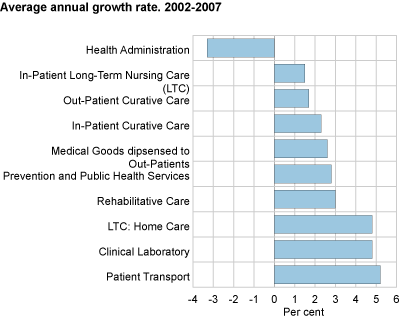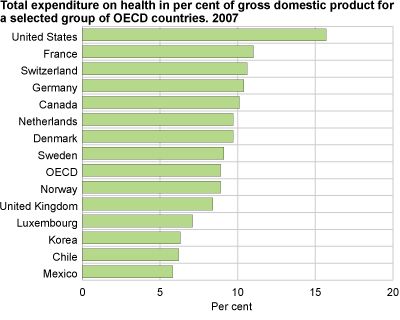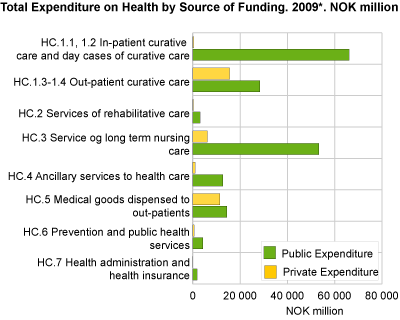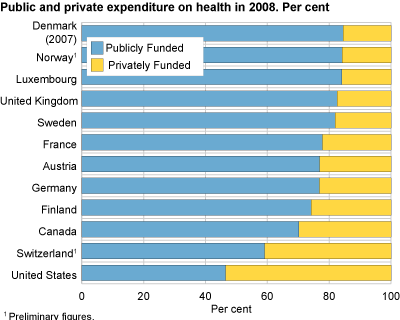Content
Published:
This is an archived release.
Health expenditure increase continues
Health expenditure continues to increase, as does our Gross Domestic Product (GDP). Some of this increase in wealth is used on health. Measured as a share of GDP, health expenditure accounted for 9.6 per cent in 2009.
Total health expenditure in 2009 was approximately NOK 229 billion, according to preliminary estimates, or NOK 47 350 per capita. When comparing GDP shares over time, GDP Mainland Norway is commonly used. The reason is that our GDP may vary quite substantially due to oil price fluctuations. After a short period where health expenditure as a share of GDP Mainland Norway was slightly below 12 per cent, the share is now 12.4 per cent, as it was in the period 2002-2004.
| 1999 | 2000 | 2001 | 2002 | 2003 | 2004 | 2005 | 2006 | 2007 | 2008* | 2009* | |||||||||||||||||||||||||||||||||||||||||||||||||||||||||||||||||||||
|---|---|---|---|---|---|---|---|---|---|---|---|---|---|---|---|---|---|---|---|---|---|---|---|---|---|---|---|---|---|---|---|---|---|---|---|---|---|---|---|---|---|---|---|---|---|---|---|---|---|---|---|---|---|---|---|---|---|---|---|---|---|---|---|---|---|---|---|---|---|---|---|---|---|---|---|---|---|---|---|
| Total expenditure on health. NOK million | 115 711 | 124 728 | 135 266 | 150 029 | 159 572 | 168 237 | 176 984 | 186 761 | 201 722 | 217 085 | 228 643 | ||||||||||||||||||||||||||||||||||||||||||||||||||||||||||||||||||||
| Total expenditure on healt in current prices in per cent of GDP | 9.3 | 8.4 | 8.8 | 9.8 | 10.0 | 9.7 | 9.1 | 8.6 | 8.9 | 8.6 | 9.6 | ||||||||||||||||||||||||||||||||||||||||||||||||||||||||||||||||||||
| Total expenditure on health in current prices in per cent of GDP Mainland Norway | 11.1 | 11.2 | 11.5 | 12.3 | 12.5 | 12.4 | 12.2 | 11.8 | 11.7 | 12.0 | 12.4 | ||||||||||||||||||||||||||||||||||||||||||||||||||||||||||||||||||||
| Total expenditure on healt in current prices per capita | 25 933 | 27 773 | 29 968 | 33 059 | 34 957 | 36 638 | 38 281 | 40 072 | 42 836 | 45 527 | 47 351 | ||||||||||||||||||||||||||||||||||||||||||||||||||||||||||||||||||||
Average annual health expenditure growth, measure at fixed prices, has been approximately 2.4 per cent the last 10 years. The equivalent growth in GDP has been 1.7 per cent. When excluding investment in health, the average annual growth rate for health expenditure was 2.8 per cent.
Health services in Norway - growth differences
The average annual growth rate for the different health services in Norway, measured at fixed prices in the period 2002-2007, varies quite substantially.
The highest growth rate is found in patient transportation, with a little above 5 per cent. These services, however, account for less than three per cent of total current health expenditure. Clinical laboratories, with the second largest average annual growth rate, at 4.8 per cent, account for 3.8 per cent of current health expenditure. Long-term nursing care - home care, which accounts for 8.8 per cent, has also had an annual growth rate of 4.8 per cent. Hospital services, accounting for almost 30 per cent of the total, have had an annual growth rate of 2.3 per cent. During this period, health administration has slightly decreased. The values involved here are small, thus small changes in the values may cause relatively large percentage fluctuations.
United States - the big spender
The USA spends far more on health than any other OECD country when measured as a share of GDP. In 2007 their share was 15.7 per cent, with France second at 11 per cent. Norway was at the OECD average, with 8.9 per cent, while Mexico had the lowest share, with 5.9 per cent.
Public vs. private expenditure in Norway and some other OECD countries
Health services in Norway are mainly publicly financed, as shown in figure 3, with some exceptions, such as out-patient curative care. These services comprise general practitioners, specialists, dentists, physiotherapists and chiropractors. Households’ out-of-pocket payments cover almost 35 per cent of the cost of these services. They cover an even larger share of expenditure for medical goods; almost 45 per cent, whereas 10 per cent of long term nursing care is financed by households’ out-of-pocket payments.
Compared to some other OECD countries in 2008, Norway has the second largest share of public financing, at 84.2 per cent. In almost all of the countries depicted here, public expenditure accounts for 75 per cent or more. Switzerland and the USA stand out, with private financing shares of 41 and 54 per cent respectively.
Tables:
- Table 1 Health expenditure, key figures. 1997-2008
- Table 2 Current expenditure on health, by function of care. 1997-2008. NOK million
- Table 3 Total current expenditure on health by function, distributed by source of funding. 2007. Per cent
- Table 4 Total current expenditure on health by function, distributed by source of funding. 2003. Per cent
- Table 5 Total current expenditure on health by function, distributed by source of funding. 2000. Per cent
- Table 6 Total current expenditure on health by function, distributed by source of funding. 1997. Per cent
- Table 7 Total current expenditure by provider distributed by source of funding. 2007. Per cent
- Table 8 Total current expenditure by provider distributed by source of funding. 2003. Per cent
- Table 9 Total current expenditure by provider distributed by source of funding. 1997. Per cent
Contact
-
Eirik Larsen Lindstrøm
E-mail: eirik.lindstrom@ssb.no
tel.: (+47) 46 78 22 92




